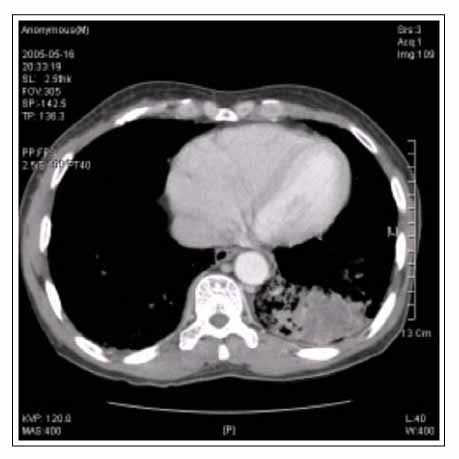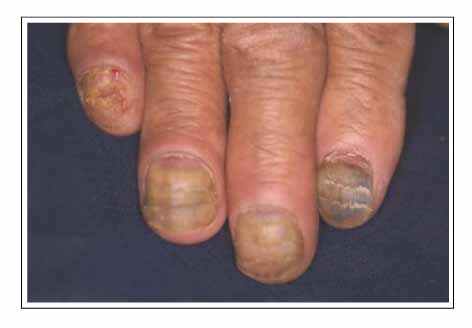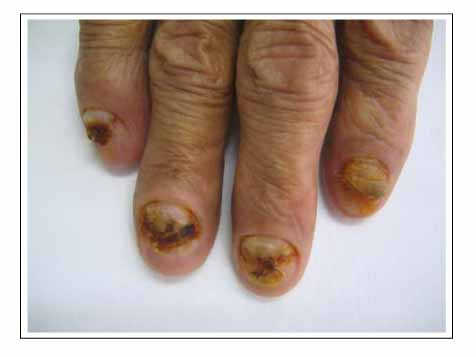Tuberc Respir Dis.
2007 Feb;62(2):125-128. 10.4046/trd.2007.62.2.125.
A Case of Subungal Abscess and Onycholysis Induced by Docetaxel
- Affiliations
-
- 1Departments of Internal Medicine, The Yonsei University College of Medicine, Seoul, Korea. yschang@yumc.yonsei.ac.kr
- 2Institute of Chest Diseases, The Yonsei University College of Medicine, Seoul, Korea.
- KMID: 2114599
- DOI: http://doi.org/10.4046/trd.2007.62.2.125
Abstract
- Docetaxel is a taxoid antineoplastic drug, which is widely used to treat locally advanced or metastatic non-small cell lung cancer (NSCLC). Among the adverse dermatological reactions, nail disorders such as bending, onycholysis, hypo- or hyperpigmentation are rare. We report a case of a 62-year-old male with advanced NSCLC (cT4N3M1, stage IV), who developed purulent discharge and onycholysis in the nail of all his fingers and the left great toe after five courses of anti-neoplastic chemotherapy, which included docetaxel (cumulative dose: 370 mg/m2, 590 mg). Seven days after the final session of chemotherapy, the patient had become aware of discoloration and swelling of the nail beds with out pain. Three days later, greenish-yellow purulent discharge oozed out from the involved nails. Microbiologic studies revealed Pseudomonas aeruginosa. Intravenous and topical antibiotics (mupirocin) were applied. After 2 weeks, regrown nails were observed and the onycholysis had improved.
Keyword
MeSH Terms
Figure
Reference
-
1. Miller VA, Krug LM, Ng KK, Pizzo B, Perez W, Heelan RT, et al. Phase II trial of docetaxel and vinorelbine in patients with advanced non-small-cell lung cancer. J Clin Oncol. 2000. 18:1346–1350.2. Janinis J, Papadakou M, Panagos G, Panousaki A, Georgoulias V, Hatzidaki D, et al. Sequential chemoradiotherapy with docetaxel, cisplatin, and 5-fluorouracil in patients with locally advanced head and neck cancer. Am J Clin Oncol. 2001. 24:227–231.3. Tinio P, Bershad S, Levitt JO. Docetaxel-induced onycholysis. J Am Acad Dermatol. 2005. 52:350–351.4. Obermair A, Binder M, Barrada M, Bancher-Todesca D, Asseryanis E, Kubista E. Onycholysis in patients treated with docetaxel. Ann Oncol. 1998. 9:230–231.5. Almagro M, Pozo JD, Garcia J, Vasquez A, Fonseca E. Nail alterations secondary to paclitaxel therapy. Eur J Dermatol. 2000. 10:146–147.6. Moisidis C, Mobus V. Erythema multiforme major following docetaxel. Arch Gynecol Obstet. 2005. 271:267–269.7. Minisini AM, Tosti A, Sobrero AF, Mansutti M, Piraccini BM, Sacco C, et al. Taxane-induced nail changes: incidence, clinical presentation and outcome. Ann Oncol. 2003. 14:333–337.8. Correia O, Azevedo C, Pinto Ferreira E, Braga Cruz F, Polonia J. Nail changes secondary to docetaxel (Taxotere). Dermatology. 1999. 198:288–290.9. Vanhooteghem O, Andre J, Vindevoghel A, Vandenbossche L, Vandeveire A, Song M. Docetaxel-induced subungal hemorrhage. Dermatology. 1997. 194:419–420.10. Lee MS, Kim HO, Park YM. A case of subungal abscess and onycholysis related to docetaxel. Korean J Dermatol. 2003. 41:1393–1395.11. Nicolopoulos J, Howard A. Docetaxel-induced nail dystrophy. Australas J Dermatol. 2002. 43:293–296.12. Wasner G, Hilpert F, Schattschneider J, Binder A, Pfisterer J, Baron R. Docetaxel-induced nail changes: a neurogenic mechanism: a case report. J Neurooncol. 2002. 58:167–174.13. Jones R, Ryan M, Friedlander M. Carboplatin hypersensitivity reactions: retreatment with cisplatin desensitisation. Gynecol Oncol. 2003. 89:112–115.14. Scotte F, Tourani JM, Banu E, Peyromaure M, Levy E, Marsan S, et al. Multicenter study of a frozen glove to prevent docetaxel-induced onycholysis and cutaneous toxicity of the hand. J Clin Oncol. 2005. 23:4424–4429.
- Full Text Links
- Actions
-
Cited
- CITED
-
- Close
- Share
- Similar articles
-
- A Case of Subungal Abscess And Onycholysis Related to Docetaxel
- A Case of Taxane-induced Onycholysis and Subungual Abscesses
- Docetaxel-Induced Onycholysis: The Role of Subungual Hemorrhage and Suppuration
- A Case of Nail Changes Secondary to Docetaxel
- A Case of Onychomadesis and Onycholysis in a Patient with Kawasaki Disease





